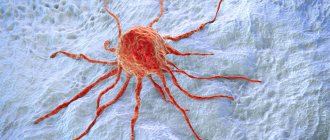- Home >
- Directory >
- How to distinguish a benign tumor from a malignant one on MRI?
If your doctor suspects you or your loved ones have a tumor, you will probably want to try to find out for yourself whether the tumor is malignant or not. We remind you that only a doctor can make a correct diagnosis: do not get upset or relax ahead of time. But in order to better understand the topic, we advise you to read this article.
Benign and malignant tumors
Before moving on to the appearance of tumors, let’s figure out what the fundamental difference between these two formations is:
- Benign tumor: Slow growing
- Incapable of creating metastases, that is, spreading throughout the body
- Easy to treat
- May develop into malignant with further enlargement and if located close to internal organs
- Grows fast
However, it is worth remembering that the division is quite arbitrary, and these characteristics are not always strictly observed, but most often this is the case. To determine the nature of the tumor, its size, and stage of development, it is optimal to perform an MRI with contrast. What visual markers do these tumors have on MRI?
MRI in our center
Power 1.5 Tesla
High image quality
Study for patients up to 250 kg
Burn to disc for free
GBUZ LO "Tosnenskaya Clinical Interdistrict Hospital"
Any tumor, by its origin, is a pathological neoplasm that occurs as a result of disruption of the mechanisms of cell division, growth, and differentiation. Tumor cells, in comparison with normal cells, have a number of features: a tendency to uncontrolled and chaotic division, loss of structure and function inherent in healthy cells, transformation of the composition of antigens, a tendency to aggressive growth and destruction of surrounding tissues. The process of a cell acquiring the above characteristics is called tumor conversion (transformation). Clinically, a tumor is a source of growth of abnormal tissue in various organs and tissues of the human body.
If we turn to statistical information, we can see that the incidence of benign tumors is much higher than malignant ones, although the number of the latter is also not small.
Before comparing benign and malignant tumors , let's try, as far as possible, to define these two concepts. So:
— Benign tumor
This is a formation whose cells, during oncological transformation, lose the ability to control their division, but at the same time do not lose the ability (partially or almost completely) to differentiate. But as for the structure, a benign neoplasm resembles the tissue from which it originates (epithelial, muscle, connective tissue). Also, this type of tumor is characterized by partial preservation of the special functions of the tissue. Clinically, such a tumor manifests itself in the form of a slowly growing neoplasm of various localizations. As the tumor grows, it gradually pushes away and compresses the structures and tissues that surround it, but at the same time never grows into them.
Treatment of benign tumors , in most cases, does not cause much difficulty and such tumors are effectively removed surgically. Benign tumors do not tend to recur.
— Malignant tumor
This is a neoplasm, the cells of which undergo serious changes, which lead to a complete loss of the ability to control their division and differentiation (the degree of cell development). Based on the degree of differentiation, highly, moderately, poorly and undifferentiated tumors are distinguished. Sometimes, due to a low level of cell differentiation, a tumor can become so atypical and unrecognizable that it becomes completely impossible to determine the source from which it arose. Even histological examination does not always make it possible to determine the source tissue of such a tumor. The clinical manifestations of a malignant tumor are quite varied. Such neoplasms are prone to focal growth and to germinate into surrounding tissues and organs. They have extremely fast and aggressive growth, and are also capable of provoking the formation of metastases, growing into blood and lymphatic vessels.
Treatment of malignant tumors is very difficult; it requires a special individual approach and the use of aggressive methods of therapy. They often recur. In the presence of metastases in distant organs, the prognosis is usually unfavorable.
So what is the main difference between a benign tumor and a malignant one? There are several important differences that determine the nature of the tumor.
Differences between a benign tumor and a malignant one
1 . Atypia (atypicality) and polymorphism (diversity of structure) of cells
Benign tumor cells are similar in structure and function to normal body tissue cells. Differences from healthy cells are still present, but they are minimal. Benign tumor cells are only highly differentiated.
The cells of malignant tumors differ markedly in structure and function from normal cells. They are moderately or poorly differentiated. In the cases described above, when it is not possible to histologically determine the origin of the tumor, the cells of such a tumor are considered undifferentiated. They tend to divide very quickly and frequently, so they do not have time to acquire similar features to normal cells and look like stem cells (cells that are considered “mother” and from which healthy cells develop, having gone through several stages of division). In order to diagnose malignant tumors if it is impossible to identify undifferentiated cells, they resort to the use of biochemical and cytogenetic diagnostic methods.
- Growth pattern
As already mentioned, benign tumors have the ability to grow expansively: the tumor grows slowly, enlarging and pushing apart surrounding tissues and organs. And malignant tumors have infiltrating growth, which means rapid development and infiltration into neighboring tissues that surround the tumor, while growing into nerves and blood vessels.
- Metastasis
Metastases are sites where tumor cells are eliminated; metastasis is the actual process of metastasis formation. As a tumor grows, its cells can break away from it and, through the blood or lymph flow, be transferred to other organs and tissues. There they provoke the growth of a secondary (daughter) tumor, which will be identical in structure to the parent tumor. Only malignant neoplasms have the ability to metastasize.
- Recurrence
Tumor recurrence is the re-development of a tumor in the same anatomical area after its successful removal or destruction. The ability to recur is found only in malignant tumors, as well as in those benign tumors that have a base, the so-called “leg”.
A relapse is spoken of only if the tumor has been completely removed and individual cancer cells remain in its place, which triggered the re-development of the tumor. In cases of partial removal of the tumor, its re-development is not considered a relapse, but is referred to in oncology as progression of the pathological process.
- Systemic effect on the patient
This is another significant difference between the two types of tumors .
Benign tumors usually manifest themselves locally: they cause a number of inconveniences, cause a feeling of discomfort, and can compress nearby nerves, blood vessels and surrounding organs. Death as a result of exposure to a benign tumor is possible only in exceptional cases, more often when it is close to the brain or with certain tumors of the body’s endocrine system.
Malignant tumors are primarily manifested by a systemic reaction of the body. This happens because malignant neoplasms cause cancer intoxication (poisoning), which can be so strong, even cancer cachexia (wasting). This happens for two reasons: firstly, rapidly multiplying tumor cells need nutrients, which they actively consume, while healthy tissues of the body begin to literally “starve”. The second reason is the disintegration of the tumor, due to a lack of its blood supply, because the blood vessels simply do not have time to grow at the same pace as the development of pathological cells. Decay products simply poison the human body.
All these factors, of course, deplete the body and cause inflammatory processes in the body. Hence the symptoms of a malignant tumor : weakness, lethargy, general malaise, increased body temperature. Due to decreased immunity, the patient becomes more vulnerable to various infections.
They also distinguish stages of malignant tumors , which characterize the degree of development of the process and give doctors an idea of possible treatment methods for such a patient and prognosis.
Stages of malignant tumors
Stage 1: the formation is small in size, located in a limited area, does not grow into the wall of a neighboring organ, and does not have metastases.
Stage 2: the formation is large, does not extend beyond the organ, there may be single metastases to regional lymph nodes.
Stage 3: a large formation, with an area of decay, grows through the entire wall of the organ; or a small formation with the presence of multiple metastases in regional lymph nodes.
Stage 4: the tumor has grown into surrounding tissues, including those that cannot be removed surgically (aorta, vena cava, etc.); or any tumor with distant metastases.
As for the types of tumors, the types of benign tumors , like the types of malignant ones, are named and differ according to the type of tissue from which they originated, for example: a benign tumor originating from adipose tissue is called lipoma (from the Greek fat), and a malignant tumor originating from connective tissue, called sarcoma (from ancient Greek - “flesh”, “meat”).
In order to protect yourself as much as possible from the formation of tumor processes in the body, you need to lead a healthy lifestyle, eat right, limit stress factors in life, and also be sure to undergo preventive examinations once a year to make sure that everything is in order with your body or in If an illness is detected, start treatment on time!
Share news
Malignant tumor on MRI
A cancerous tumor on MRI is characterized by the following signs:
- Fuzzy outlines
- Ingrowth of pathological cells into healthy tissues
- Heterogeneous structure
- Severe perifocal edema
- Intense accumulation of contrast agent
These are the most common signs of tumors, but do not rush to diagnose yourself. Only a doctor can determine which tumor you have. This may require not only an MRI, but also other examinations: for example, a biopsy.
If you have any questions, ask our specialist!
Ask a Question
Types of tumors
Benign:
- cysts;
- nevi or moles;
- nodules whose name has the oma suffix: fibroma, myoma, adenoma, papilloma - depending on the specific tissue.
Malignant:
- formations whose name is appended with the word carcinoma, sarcoma, blastoma, blastosis (fibroblastoma, myosarcoma, adenocarcinoma);
- oncological diseases of the blood - lymphogranulomatosis, leukemia and others;
- skin cancer - melanoma, basal cell carcinoma.
The differences are not always obvious. A thorough diagnosis is needed to look for atypical cells.
Diagnosis of cancer in St. Petersburg
A timely diagnosis is the key to successful treatment. That’s why it’s so important to choose a clinic where experienced doctors will diagnose you using modern equipment. Otherwise, you risk wasting time and money and contributing to the development of pathology.
MRI at the Elena Malysheva Diagnostic Center means only qualified doctors with many years of experience, modern equipment and confidence in the result!
Sign up for an MRI at the Elena Malysheva Diagnostic Center near the Baumanskaya metro station (see map) by phone or leave a request on the website.
Baumanskaya metro station (see map) 8
leave a request on the website
1.What are tumors and why do they appear?
A tumor is a pathological formation in the organs and tissues of the body, resulting from abnormal and uncontrolled cell growth. The science that studies the causes of tumors, their types, development, as well as methods of treating tumors is called oncology
.
The development of tumors is associated with the presence of a certain genetic predisposition, as well as disturbances in the functioning of the immune system. Various factors can trigger the appearance of a tumor, for example, mechanical stress (constant tissue friction, injury), exposure to ultraviolet radiation, ionizing radiation, chemicals (including tobacco smoke), as well as some bacteria.
A must read! Help with treatment and hospitalization!
The main causes of solid formations in cancer
A solid formation is a cancer that can appear in almost any system of the body. However, there are a number of reasons that, according to experts, are peculiar provocateurs and stimulate the appearance and spread of metastases.
Solid formation (cancer) can occur due to the following phenomena:
- unfavorable environmental conditions, especially in densely populated cities and cities with large plants and factories;
- an abundance of stress and excessive psychological stress;
- alcoholism and smoking;
- bad heredity;
- weak immune system;
- frequent fractures and other injuries.
Tumor stage according to the TNM system
| T | N | M |
| is – tumor growth within the mucosa | 0 – no data for lymph node involvement | 0 – no data for the presence of distant metastases |
| 1 the tumor grows, but does not invade the submucosal layer of the intestine | 1 damage from 1 to 3 lymph nodes | 1 presence of distant tumor metastases |
| 2 the tumor grows, but does not invade the muscle layer of the intestine | 2 damage to more than 3 lymph nodes | x it is unknown whether there are metastases |
| 3 the tumor grows through the muscle layer into the surrounding tissue | x unknown whether lymph nodes are involved | |
| 4 the tumor grows into surrounding organs |
Classification of solid formations
Any solid formation (oncology) belongs to one of the following categories: benign or malignant.
Benign tumor
It grows slowly and can decrease on its own without additional intervention. There are no metastases.
The main problem that this solid formation (cancer) poses is the compression of neighboring organs or tissues.
Malignant tumor
It consists of tirelessly dividing cells that have changed their appearance and structure and can grow to considerable sizes.
The phenomenon manifests itself in an extremely aggressive manner, spreading metastases even in the earliest stages of the disease.
General tumor stage
| T | N | M | |
| Stage | 1,2 | 0 | 0 |
| Stage | 3,4 | 0 | 0 |
| Stage | Any | 1,2 | 0 |
| Stage | Any | Any | 1 |
To understand how the stage is set, look for the headings T, N, and M in the table. Each column contains numbers or the word “any.” The second row in the table corresponds to stage I, the columns contain the following data: stage T 1 or 2, stages N and M - 0. This means that if the tumor grows only into the intestinal wall (stage T1 or T2) and there is no cancer in any lymph node cells (stage N0), and there are no distant metastases (stage M0), then the tumor will be classified as stage I cancer. A tumor that grows through the intestinal wall (stage T3 or T4), but there are no affected lymph nodes or distant metastases, is stage II, and so on.
Staging plays a very important role in determining treatment tactics. Stage I tumors are usually treated with surgery alone, while stage III tumors are usually treated with both surgery and chemotherapy. Thus, tumor staging is a very important stage of preoperative diagnosis. Many tests may be required to determine the stage before surgery. Computed tomography (CT), chest X-ray, ultrasound (US), magnetic resonance imaging (MRI) and positron emission tomography (PET) are very informative tests that help determine the extent of tumor spread. However, the most accurate method for determining the stage of the tumor is to examine the part of the intestine removed during surgery using a microscope.
It is very important that patients understand the principles of tumor staging and have an idea of how this is done in order to competently discuss treatment options and prognosis with their doctor.
Features of cystic-solid formations
- Solid formation (cancer) is the most dangerous condition in which the chances of recovery from the disease are minimal; it has a hard shell and is filled with tissue.
- In contrast, a cystic neoplasm is easy to treat, is soft, and can grow and shrink.
- Cystic-solid formation is an intermediate link between them. It can appear in any organ, change in size or remain unchanged, and also contain both tissue and liquid substance.









